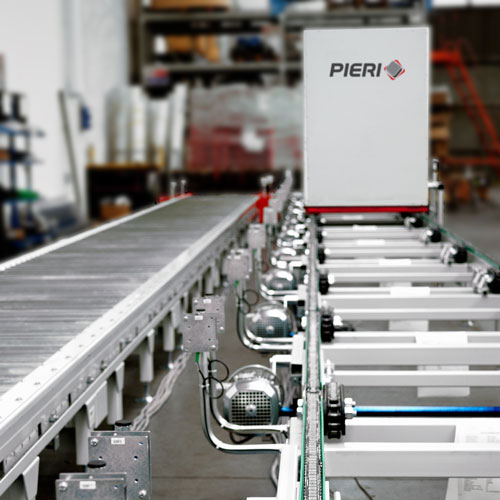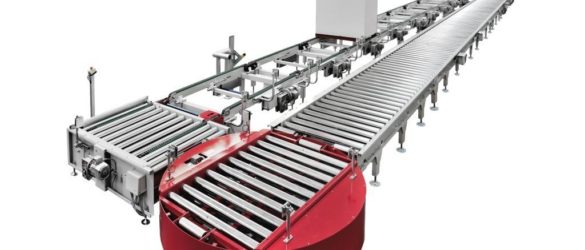
Pallet handling: how does it work and which technologies does it involve? (The Final Guide)
Pallet handling occurs through industrial systems such as roller conveyors or roller conveyors of loads and goods inside warehouses, distribution centers or production machinery.
Thanks to these systems, pallet handling works in a fast and efficient way, allowing an easier passage on prearranged paths without the help of any specialized operator, who can be addressed to other tasks.
Here follow the main features of motorized roller conveyors but not those for pallet handling, by analysing the main applications and highlighting the benefits deriving from their usage.

Systems for pallet handling: how many typologies exist?
Basically, there are 4 kinds of roller conveyors and transports for pallet handling: roller idler conveyor, motorized roller conveyor, expandable roller conveyor and shuttle conveyor.
Idler Conveyor
Transporters that work through gravity are called roller idler conveyor. Often, most of the transporters that you can find in airports at security checks or in supermarkets. The idler conveyor is none other than a sequence of cylindrical rollers, usually inclined.
In order to move the objects above the rollers a push or gravity force is needed without the necessity of a real pulling force.
Motorized roller conveyor
Motorized roller conveyors are useful in particular for pallet handling. They are composed of motor and traction, which make it possible for them to move autonomously. Rollers can be moved by using a belt driven system, which allows to mobilize roller conveyors with just one motorization for lengths until 12 meters and for the transport of goods with a maximal unitary weight of 30 kilograms. Moreover, ring chain or O-rings belt can be used.
Expandable roller conveyor
In factories transporters of variable length, which can adapt themselves to different types of production demands, are needed. In this case one could use transporters for pallet handling, also called “expandable roller conveyor”, motorized or idler. In this case rollers are built over pantographs which permits it to extend.
Shuttle conveyor
The shuttle conveyor is composed of a unique unit on rail for pallet handling. It is recommended especially for lines with more loading and unloading places, which, thanks to this conveyor can be reached in a faster way, therefore optimizing the lines productivity and efficiency.
How do pallet roller conveyors work and what are they useful for?
Here are the main uses of pallet roller conveyors:
- Goods Handling
Motorized roller conveyors are always used in shipping and delivery points in order to simplify the sliding of pallet and containers.
- Goods entries and truck unloading: transporters in this case are used in order to move the pallet that is going to be stored.
When working with small package or boxes, it is possible to install roller conveyors almost close to the loading place so that the circuit can be activated in that precise point. - Goods delivery and truck loading: roller conveyors are installed close to the loading places in order to simplify the organization and sorting of wares in the trucks.
- Connect different areas of the store
It is possible to project transporters for pallet handling in order to connect different areas of the store. There are roller conveyors with a plug and play system which work without the necessity of a control software.
- Facilitate the handling in stores with more floors
Connecting different areas of the store, allows the company to become much more efficient. In order to do so one resorts to the three following solutions:
- Vertical transporters: in general roller conveyors are combined with conveyor belts. This solution perfectly fits warehouses with a high picking activity.
- Pallet elevators with roller conveyors: they are very similar to an elevator which connects the different floors of a store.
- Spiral elevators: the movement in this case is bidirectional.
Pros and Cons of systems for pallet handling
As any automatic system, also roller conveyors have many pros and cons to take into account when choosing to adopt this solution inside one’s own company.
Advantages
- Savings. Automatized systems for pallet handling speed up productivity. Work develops in a faster way and with less resources than manual equipment. This allows entrepreneurs to save their money because they will have to hire less workers to manage them.
- Reach greater efficiency. Workers are able to carry out the tasks in a better way thanks to the usage of automatized machinery, therefore they work in a much more efficient way.
- Growth in the total value of the store. Systems for pallet handling increase the resale value of the store, allowing at the same time a bigger appeal in front of a potential buyer’s eyes.
- Big versatility. Solutions exist for basically any case.
- Fast and secure system. Thanks to sensors and to other security components, the risk of damage of the goods decreases.
- Trustworthy solution in logistical field. They have been employed inside the stores for many years.
- Big resistance and longevity. Roller conveyor are made for lasting, therefore it is a secure investment you can easily amortize during the time. Pieri’s roller conveyors, for example, last at least 15 years.
Disadvantages
- Cleaning. Systems for pallet handling complicate the cleaning of the store.
- Surface involved. Roller conveyors reduce space by encumbering the available space inside the structure.
Curious of knowing more about it? Take a look at how a system for pallet handling works in this video:
Find out Pieri’s systems for pallet handling at this page.
Do you need a custom-made solution for your company? Contact us, we are happy to take on your project!
